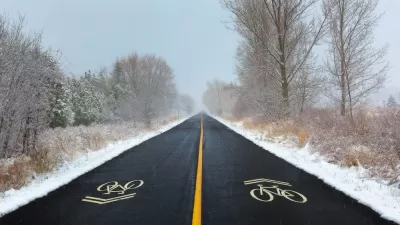Proliferating faster than bike lanes or bike parking racks may be the chevron symbols in the pavement with bicycle icon informing cyclists and motorists alike to "share the road". But can too many sharrows be a bad thing, asks Grist's Elly Blue.
Ms. Blue reports from Seattle where the sharrow has become somewhat ubiquitous since it was included in the 2007 Bike Master Plan.
"A 'sharrow' -- the word is an amalgamation of "arrow" and "share the road" -- is a larger-than-life thermoplastic symbol of a bicycle topped by two chevrons pointing the way forward.
Sharrows have been increasing in popularity nationwide, and got a boost in 2009 when they were officially entered into the federal transportation engineering canon.
Like many experts on transportation bicycling, Tom Fucoloro, proprietor of the Seattle Bike Blog, wasn't enthusiastic about them. Sharrows are spread so indiscriminately on Seattle streets, he said, that "they mean nothing now." He has noticed that there seems to be "slightly less aggression" from drivers when they're in place. "But does that mean all the streets without sharrows are worse?"
A 2004 study prepared by Alta Planning + Design for the San Francisco Department of Parking & Traffic "says sharrows slow car traffic slightly, and make bicyclists a little safer. But they are even better at keeping drivers at a distance from parked cars -- once again, bike infrastructure benefits more than just people on bikes."
From Seattle Bike Blog: Elly Blue's take on sharrows after a recent trip to Seattle: Tom Fucoloro describes his visit with "Elly Blue, a prolific bicycle writer and zine editor from Portland. Our conversation made its way to sharrows, which are the topic of her most recent story for Grist. Seattle's sharrows are a rather confused road marking, but legally, they don't do anything."
FULL STORY: BIKING Sharing time: Tracking the ‘sharrow’ on city streets

Manufactured Crisis: Losing the Nation’s Largest Source of Unsubsidized Affordable Housing
Manufactured housing communities have long been an affordable housing option for millions of people living in the U.S., but that affordability is disappearing rapidly. How did we get here?

Americans May Be Stuck — But Why?
Americans are moving a lot less than they once did, and that is a problem. While Yoni Applebaum, in his highly-publicized article Stuck, gets the reasons badly wrong, it's still important to ask: why are we moving so much less than before?

Research Shows More Roads = More Driving
A national study shows, once again, that increasing road supply induces additional vehicle travel, particularly over the long run.

Judge Halts Enforcement of Anti-Homeless Laws in Grants Pass
The Oregon city will be barred from enforcing two ordinances that prosecute unhoused residents until it increases capacity and accessibility at designated camping sites.

Advancing Sustainability in Los Angeles County Schools
The Los Angeles County Office of Education’s Green Schools Symposium brings together educators, students, and experts to advance sustainability in schools through innovative design, climate resilience strategies, and collaborative learning.

Using Old Oil and Gas Wells for Green Energy Storage
Penn State researchers have found that repurposing abandoned oil and gas wells for geothermal-assisted compressed-air energy storage can boost efficiency, reduce environmental risks, and support clean energy and job transitions.
Urban Design for Planners 1: Software Tools
This six-course series explores essential urban design concepts using open source software and equips planners with the tools they need to participate fully in the urban design process.
Planning for Universal Design
Learn the tools for implementing Universal Design in planning regulations.
City of Moreno Valley
Institute for Housing and Urban Development Studies (IHS)
City of Grandview
Harvard GSD Executive Education
NYU Wagner Graduate School of Public Service
City of Cambridge, Maryland
Newport County Development Council: Connect Greater Newport





























